Example 32 - Folded Layers
Contents
Example 32 - Folded Layers#
This example will show how to convert the geological map below using GemGIS to a GemPy model. This example is based on digitized data. The area is 601 m wide (W-E extent) and 705 m high (N-S extent). The vertical model extents varies between 0 m and 300 m. The model represents two folded stratigraphic units (blue and red) above an unspecified basement (yellow). The map has been georeferenced with QGIS. The stratigraphic boundaries were digitized in QGIS. Strikes lines were digitized in
QGIS as well and were used to calculate orientations for the GemPy model. These will be loaded into the model directly. The contour lines were also digitized and will be interpolated with GemGIS to create a topography for the model.
Map Source: Unknown
[1]:
import matplotlib.pyplot as plt
import matplotlib.image as mpimg
img = mpimg.imread('../images/cover_example32.png')
plt.figure(figsize=(10, 10))
imgplot = plt.imshow(img)
plt.axis('off')
plt.tight_layout()

Licensing#
Computational Geosciences and Reservoir Engineering, RWTH Aachen University, Authors: Alexander Juestel. For more information contact: alexander.juestel(at)rwth-aachen.de
This work is licensed under a Creative Commons Attribution 4.0 International License (http://creativecommons.org/licenses/by/4.0/)
Import GemGIS#
If you have installed GemGIS via pip or conda, you can import GemGIS like any other package. If you have downloaded the repository, append the path to the directory where the GemGIS repository is stored and then import GemGIS.
[2]:
import warnings
warnings.filterwarnings("ignore")
import gemgis as gg
Importing Libraries and loading Data#
All remaining packages can be loaded in order to prepare the data and to construct the model. The example data is downloaded from an external server using pooch. It will be stored in a data folder in the same directory where this notebook is stored.
[3]:
import geopandas as gpd
import rasterio
[4]:
file_path = 'data/example32/'
gg.download_gemgis_data.download_tutorial_data(filename="example32_folded_layers.zip", dirpath=file_path)
Downloading file 'example32_folded_layers.zip' from 'https://rwth-aachen.sciebo.de/s/AfXRsZywYDbUF34/download?path=%2Fexample32_folded_layers.zip' to 'C:\Users\ale93371\Documents\gemgis\docs\getting_started\example\data\example32'.
Creating Digital Elevation Model from Contour Lines#
The digital elevation model (DEM) will be created by interpolating contour lines digitized from the georeferenced map using the SciPy Radial Basis Function interpolation wrapped in GemGIS. The respective function used for that is gg.vector.interpolate_raster().
[5]:
img = mpimg.imread('../images/dem_example32.png')
plt.figure(figsize=(10, 10))
imgplot = plt.imshow(img)
plt.axis('off')
plt.tight_layout()

[6]:
topo = gpd.read_file(file_path + 'topo32.shp')
topo['Z'] = topo['Z']*0.425
topo.head()
[6]:
| id | Z | geometry | |
|---|---|---|---|
| 0 | None | 170.00 | LINESTRING (0.994 52.851, 36.954 48.266, 68.32... |
| 1 | None | 148.75 | LINESTRING (1.235 98.706, 42.022 94.603, 80.39... |
| 2 | None | 127.50 | LINESTRING (1.477 157.955, 44.435 147.818, 81.... |
| 3 | None | 127.50 | LINESTRING (1.597 320.738, 11.492 310.722, 22.... |
| 4 | None | 106.25 | LINESTRING (553.299 3.497, 534.233 30.527, 513... |
Interpolating the contour lines#
[7]:
topo_raster = gg.vector.interpolate_raster(gdf=topo, value='Z', method='rbf', res=5)
Plotting the raster#
[8]:
import matplotlib.pyplot as plt
from mpl_toolkits.axes_grid1 import make_axes_locatable
fig, ax = plt.subplots(1, figsize=(10, 10))
topo.plot(ax=ax, aspect='equal', column='Z', cmap='gist_earth')
im = ax.imshow(topo_raster, origin='lower', extent=[0, 601, 0, 705], cmap='gist_earth')
divider = make_axes_locatable(ax)
cax = divider.append_axes("right", size="5%", pad=0.05)
cbar = plt.colorbar(im, cax=cax)
cbar.set_label('Altitude [m]')
ax.set_xlabel('X [m]')
ax.set_ylabel('Y [m]')
ax.set_xlim(0, 601)
ax.set_ylim(0, 705)
[8]:
(0.0, 705.0)

Saving the raster to disc#
After the interpolation of the contour lines, the raster is saved to disc using gg.raster.save_as_tiff(). The function will not be executed as a raster is already provided with the example data.
Opening Raster#
The previously computed and saved raster can now be opened using rasterio.
[9]:
topo_raster = rasterio.open(file_path + 'raster32.tif')
Interface Points of stratigraphic boundaries#
The interface points will be extracted from LineStrings digitized from the georeferenced map using QGIS. It is important to provide a formation name for each layer boundary. The vertical position of the interface point will be extracted from the digital elevation model using the GemGIS function gg.vector.extract_xyz(). The resulting GeoDataFrame now contains single points including the information about the respective formation.
[10]:
img = mpimg.imread('../images/interfaces_example32.png')
plt.figure(figsize=(10, 10))
imgplot = plt.imshow(img)
plt.axis('off')
plt.tight_layout()

[11]:
interfaces = gpd.read_file(file_path + 'interfaces32.shp')
interfaces.head()
[11]:
| id | formation | geometry | |
|---|---|---|---|
| 0 | None | Schluffstein | LINESTRING (256.467 1.534, 255.813 23.321, 262... |
| 1 | None | Tonstein | LINESTRING (217.032 1.534, 216.378 56.656, 215... |
| 2 | None | Tonstein | LINESTRING (228.797 703.524, 221.389 657.117, ... |
| 3 | None | Schluffstein | LINESTRING (303.746 703.307, 287.405 688.273, ... |
Extracting Z coordinate from Digital Elevation Model#
[12]:
interfaces_coords = gg.vector.extract_xyz(gdf=interfaces, dem=topo_raster)
interfaces_coords = interfaces_coords[interfaces_coords['formation'].isin(['Tonstein', 'Schluffstein'])]
interfaces_coords
[12]:
| formation | geometry | X | Y | Z | |
|---|---|---|---|---|---|
| 0 | Schluffstein | POINT (256.467 1.534) | 256.47 | 1.53 | 178.38 |
| 1 | Schluffstein | POINT (255.813 23.321) | 255.81 | 23.32 | 170.99 |
| 2 | Schluffstein | POINT (262.785 44.891) | 262.79 | 44.89 | 160.10 |
| 3 | Schluffstein | POINT (266.489 61.885) | 266.49 | 61.89 | 148.84 |
| 4 | Schluffstein | POINT (271.500 76.047) | 271.50 | 76.05 | 141.98 |
| ... | ... | ... | ... | ... | ... |
| 101 | Schluffstein | POINT (484.145 638.598) | 484.15 | 638.60 | 202.71 |
| 102 | Schluffstein | POINT (476.084 658.860) | 476.08 | 658.86 | 198.10 |
| 103 | Schluffstein | POINT (465.408 676.944) | 465.41 | 676.94 | 191.75 |
| 104 | Schluffstein | POINT (450.157 691.977) | 450.16 | 691.98 | 185.69 |
| 105 | Schluffstein | POINT (432.945 703.307) | 432.94 | 703.31 | 180.41 |
106 rows × 5 columns
Plotting the Interface Points#
[13]:
fig, ax = plt.subplots(1, figsize=(10, 10))
interfaces.plot(ax=ax, column='formation', legend=True, aspect='equal')
interfaces_coords.plot(ax=ax, column='formation', legend=True, aspect='equal')
plt.grid()
plt.xlabel('X [m]')
plt.ylabel('Y [m]')
plt.xlim(0, 601)
plt.ylim(0, 705)
[13]:
(0.0, 705.0)

Orientations from Strike Lines and Map#
Strike lines connect outcropping stratigraphic boundaries (interfaces) of the same altitude. In other words: the intersections between topographic contours and stratigraphic boundaries at the surface. The height difference and the horizontal difference between two digitized lines is used to calculate the dip and azimuth and hence an orientation that is necessary for GemPy. In order to calculate the orientations, each set of strikes lines/LineStrings for one formation must be given an id
number next to the altitude of the strike line. The id field is already predefined in QGIS. The strike line with the lowest altitude gets the id number 1, the strike line with the highest altitude the the number according to the number of digitized strike lines. It is currently recommended to use one set of strike lines for each structural element of one formation as illustrated.
In addition, orientations were provided on the map which were digitized as points and can be used right away.
[14]:
img = mpimg.imread('../images/orientations_example32.png')
plt.figure(figsize=(10, 10))
imgplot = plt.imshow(img)
plt.axis('off')
plt.tight_layout()
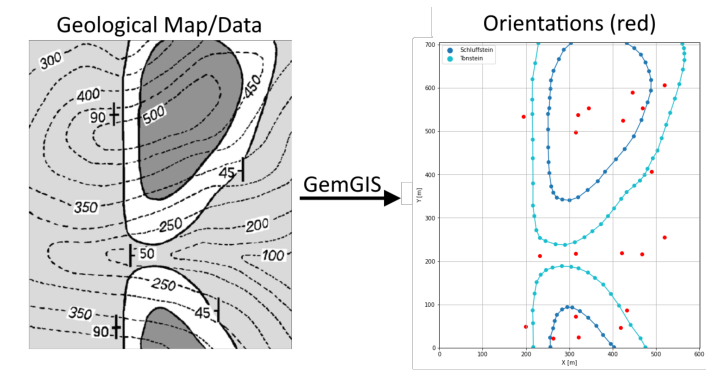
Orientations from Map#
[15]:
orientations_points = gpd.read_file(file_path + 'orientations32.shp')
orientations_points = gg.vector.extract_xyz(gdf=orientations_points, dem=topo_raster)
orientations_points
[15]:
| formation | dip | azimuth | polarity | geometry | X | Y | Z | |
|---|---|---|---|---|---|---|---|---|
| 0 | Tonstein | 89.00 | 90.00 | 1.00 | POINT (194.155 534.236) | 194.15 | 534.24 | 203.22 |
| 1 | Tonstein | 45.00 | 270.00 | 1.00 | POINT (489.592 406.562) | 489.59 | 406.56 | 140.53 |
| 2 | Tonstein | 50.00 | 90.00 | 1.00 | POINT (231.629 212.654) | 231.63 | 212.65 | 80.31 |
| 3 | Tonstein | 89.00 | 90.00 | 1.00 | POINT (199.384 48.813) | 199.38 | 48.81 | 162.43 |
| 4 | Tonstein | 45.00 | 270.00 | 1.00 | POINT (433.381 87.158) | 433.38 | 87.16 | 116.59 |
Orientations from Strike Lines#
[16]:
strikes = gpd.read_file(file_path + 'strikes32.shp')
strikes['Z'] = strikes['Z']*0.425
strikes
[16]:
| id | formation | Z | geometry | |
|---|---|---|---|---|
| 0 | 5 | Tonstein1 | 170.00 | LINESTRING (546.457 583.476, 546.022 704.178) |
| 1 | 4 | Tonstein1 | 148.75 | LINESTRING (494.168 436.411, 492.425 705.050) |
| 2 | 3 | Tonstein1 | 127.50 | LINESTRING (447.543 371.266, 443.621 703.742) |
| 3 | 2 | Tonstein1 | 106.25 | LINESTRING (401.353 319.848, 400.482 705.050) |
| 4 | 1 | Tonstein1 | 106.25 | LINESTRING (228.797 259.715, 227.054 704.178) |
| 5 | 1 | Tonstein2 | 106.25 | LINESTRING (230.976 163.414, 230.104 261.022) |
| 6 | 2 | Tonstein2 | 106.25 | LINESTRING (401.789 321.155, 396.560 126.376) |
| 7 | 3 | Tonstein2 | 127.50 | LINESTRING (447.978 372.138, 438.828 57.528) |
| 8 | 4 | Tonstein2 | 148.75 | LINESTRING (494.168 436.629, 491.117 1.316) |
| 9 | 5 | Tonstein2 | 170.00 | LINESTRING (547.329 586.090, 545.586 -0.863) |
| 10 | 1 | Tonstein3 | 106.25 | LINESTRING (231.847 162.107, 231.847 -0.427) |
| 11 | 2 | Tonstein3 | 106.25 | LINESTRING (396.996 125.940, 399.610 0.445) |
| 12 | 3 | Tonstein3 | 127.50 | LINESTRING (438.828 57.963, 438.828 0.880) |
| 13 | 2 | Schluffstein1 | 106.25 | LINESTRING (268.014 63.628, 269.321 0.880) |
| 14 | 1 | Schluffstein1 | 106.25 | LINESTRING (373.901 34.869, 375.644 0.009) |
| 15 | 3 | Schluffstein1 | 127.50 | LINESTRING (256.685 23.103, 257.556 0.880) |
| 16 | 4 | Schluffstein2 | 191.25 | LINESTRING (466.715 675.854, 467.587 527.700) |
| 17 | 3 | Schluffstein2 | 170.00 | LINESTRING (423.576 453.623, 424.012 702.871) |
| 18 | 1 | Schluffstein2 | 148.75 | LINESTRING (373.030 393.054, 373.465 703.307) |
| 19 | 2 | Schluffstein2 | 148.75 | LINESTRING (265.400 352.965, 266.707 702.871) |
Calculating Orientations for each formation#
[17]:
orientations_claystone1 = gg.vector.calculate_orientations_from_strike_lines(gdf=strikes[strikes['formation'] == 'Tonstein1'].sort_values(by='id', ascending=True).reset_index())
orientations_claystone1
[17]:
| dip | azimuth | Z | geometry | polarity | formation | X | Y | |
|---|---|---|---|---|---|---|---|---|
| 0 | 0.00 | 0.00 | 106.25 | POINT (314.421 497.198) | 1.00 | Tonstein1 | 314.42 | 497.20 |
| 1 | 26.23 | 269.64 | 116.88 | POINT (423.250 524.977) | 1.00 | Tonstein1 | 423.25 | 524.98 |
| 2 | 24.15 | 269.44 | 138.12 | POINT (469.439 554.117) | 1.00 | Tonstein1 | 469.44 | 554.12 |
| 3 | 21.76 | 269.66 | 159.38 | POINT (519.768 607.278) | 1.00 | Tonstein1 | 519.77 | 607.28 |
[18]:
orientations_claystone2 = gg.vector.calculate_orientations_from_strike_lines(gdf=strikes[strikes['formation'] == 'Tonstein2'].sort_values(by='id', ascending=True).reset_index())
orientations_claystone2
[18]:
| dip | azimuth | Z | geometry | polarity | formation | X | Y | |
|---|---|---|---|---|---|---|---|---|
| 0 | 0.00 | 0.00 | 106.25 | POINT (314.857 217.992) | 1.00 | Tonstein2 | 314.86 | 217.99 |
| 1 | 25.65 | 271.63 | 116.88 | POINT (421.289 219.299) | 1.00 | Tonstein2 | 421.29 | 219.30 |
| 2 | 24.92 | 270.84 | 138.12 | POINT (468.023 216.902) | 1.00 | Tonstein2 | 468.02 | 216.90 |
| 3 | 21.95 | 270.25 | 159.38 | POINT (519.550 255.793) | 1.00 | Tonstein2 | 519.55 | 255.79 |
[19]:
orientations_claystone3 = gg.vector.calculate_orientations_from_strike_lines(gdf=strikes[strikes['formation'] == 'Tonstein3'].sort_values(by='id', ascending=True).reset_index())
orientations_claystone3
[19]:
| dip | azimuth | Z | geometry | polarity | formation | X | Y | |
|---|---|---|---|---|---|---|---|---|
| 0 | 0.00 | 0.00 | 106.25 | POINT (315.075 72.016) | 1.00 | Tonstein3 | 315.08 | 72.02 |
| 1 | 28.45 | 269.01 | 116.88 | POINT (418.565 46.307) | 1.00 | Tonstein3 | 418.57 | 46.31 |
[20]:
orientations_siltstone1 = gg.vector.calculate_orientations_from_strike_lines(gdf=strikes[strikes['formation'] == 'Schluffstein1'].sort_values(by='id', ascending=True).reset_index())
orientations_siltstone1
[20]:
| dip | azimuth | Z | geometry | polarity | formation | X | Y | |
|---|---|---|---|---|---|---|---|---|
| 0 | 0.00 | 0.00 | 106.25 | POINT (321.720 24.846) | 1.00 | Schluffstein1 | 321.72 | 24.85 |
| 1 | 61.03 | 88.69 | 116.88 | POINT (262.894 22.123) | 1.00 | Schluffstein1 | 262.89 | 22.12 |
[21]:
orientations_siltstone2 = gg.vector.calculate_orientations_from_strike_lines(gdf=strikes[strikes['formation'] == 'Schluffstein2'].sort_values(by='id', ascending=True).reset_index())
orientations_siltstone2
[21]:
| dip | azimuth | Z | geometry | polarity | formation | X | Y | |
|---|---|---|---|---|---|---|---|---|
| 0 | 0.00 | 0.00 | 148.75 | POINT (319.650 538.049) | 1.00 | Schluffstein2 | 319.65 | 538.05 |
| 1 | 7.69 | 270.18 | 159.38 | POINT (344.924 553.082) | 1.00 | Schluffstein2 | 344.92 | 553.08 |
| 2 | 26.43 | 269.99 | 180.62 | POINT (445.473 590.012) | 1.00 | Schluffstein2 | 445.47 | 590.01 |
Merging Orientations#
[22]:
import pandas as pd
orientations = pd.concat([orientations_points, orientations_claystone1, orientations_claystone2, orientations_claystone3, orientations_siltstone1, orientations_siltstone2])
orientations['formation'] = ['Tonstein', 'Tonstein', 'Tonstein', 'Tonstein', 'Tonstein', 'Tonstein', 'Tonstein', 'Tonstein', 'Tonstein', 'Tonstein','Tonstein', 'Tonstein', 'Tonstein', 'Tonstein', 'Tonstein', 'Schluffstein', 'Schluffstein', 'Schluffstein', 'Schluffstein', 'Schluffstein']
orientations = orientations[orientations['formation'].isin(['Tonstein', 'Schluffstein'])].reset_index()
orientations
[22]:
| index | formation | dip | azimuth | polarity | geometry | X | Y | Z | |
|---|---|---|---|---|---|---|---|---|---|
| 0 | 0 | Tonstein | 89.00 | 90.00 | 1.00 | POINT (194.155 534.236) | 194.15 | 534.24 | 203.22 |
| 1 | 1 | Tonstein | 45.00 | 270.00 | 1.00 | POINT (489.592 406.562) | 489.59 | 406.56 | 140.53 |
| 2 | 2 | Tonstein | 50.00 | 90.00 | 1.00 | POINT (231.629 212.654) | 231.63 | 212.65 | 80.31 |
| 3 | 3 | Tonstein | 89.00 | 90.00 | 1.00 | POINT (199.384 48.813) | 199.38 | 48.81 | 162.43 |
| 4 | 4 | Tonstein | 45.00 | 270.00 | 1.00 | POINT (433.381 87.158) | 433.38 | 87.16 | 116.59 |
| 5 | 0 | Tonstein | 0.00 | 0.00 | 1.00 | POINT (314.421 497.198) | 314.42 | 497.20 | 106.25 |
| 6 | 1 | Tonstein | 26.23 | 269.64 | 1.00 | POINT (423.250 524.977) | 423.25 | 524.98 | 116.88 |
| 7 | 2 | Tonstein | 24.15 | 269.44 | 1.00 | POINT (469.439 554.117) | 469.44 | 554.12 | 138.12 |
| 8 | 3 | Tonstein | 21.76 | 269.66 | 1.00 | POINT (519.768 607.278) | 519.77 | 607.28 | 159.38 |
| 9 | 0 | Tonstein | 0.00 | 0.00 | 1.00 | POINT (314.857 217.992) | 314.86 | 217.99 | 106.25 |
| 10 | 1 | Tonstein | 25.65 | 271.63 | 1.00 | POINT (421.289 219.299) | 421.29 | 219.30 | 116.88 |
| 11 | 2 | Tonstein | 24.92 | 270.84 | 1.00 | POINT (468.023 216.902) | 468.02 | 216.90 | 138.12 |
| 12 | 3 | Tonstein | 21.95 | 270.25 | 1.00 | POINT (519.550 255.793) | 519.55 | 255.79 | 159.38 |
| 13 | 0 | Tonstein | 0.00 | 0.00 | 1.00 | POINT (315.075 72.016) | 315.08 | 72.02 | 106.25 |
| 14 | 1 | Tonstein | 28.45 | 269.01 | 1.00 | POINT (418.565 46.307) | 418.57 | 46.31 | 116.88 |
| 15 | 0 | Schluffstein | 0.00 | 0.00 | 1.00 | POINT (321.720 24.846) | 321.72 | 24.85 | 106.25 |
| 16 | 1 | Schluffstein | 61.03 | 88.69 | 1.00 | POINT (262.894 22.123) | 262.89 | 22.12 | 116.88 |
| 17 | 0 | Schluffstein | 0.00 | 0.00 | 1.00 | POINT (319.650 538.049) | 319.65 | 538.05 | 148.75 |
| 18 | 1 | Schluffstein | 7.69 | 270.18 | 1.00 | POINT (344.924 553.082) | 344.92 | 553.08 | 159.38 |
| 19 | 2 | Schluffstein | 26.43 | 269.99 | 1.00 | POINT (445.473 590.012) | 445.47 | 590.01 | 180.62 |
Plotting the Orientations#
[23]:
fig, ax = plt.subplots(1, figsize=(10, 10))
interfaces.plot(ax=ax, column='formation', legend=True, aspect='equal')
interfaces_coords.plot(ax=ax, column='formation', legend=True, aspect='equal')
orientations.plot(ax=ax, color='red', aspect='equal')
plt.grid()
plt.xlabel('X [m]')
plt.ylabel('Y [m]')
plt.xlim(0, 601)
plt.ylim(0, 705)
[23]:
(0.0, 705.0)
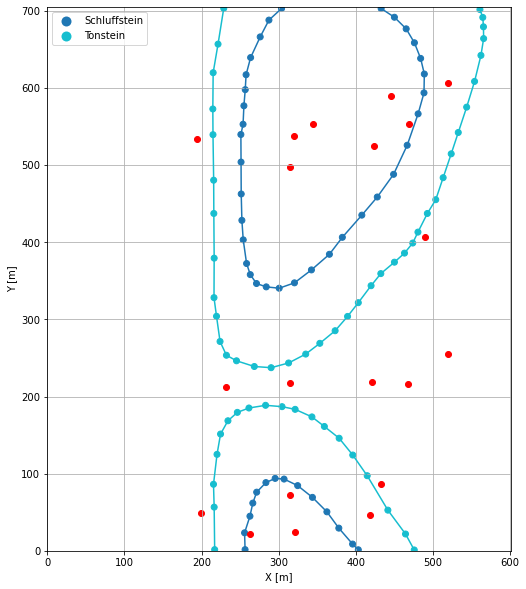
GemPy Model Construction#
The structural geological model will be constructed using the GemPy package.
[24]:
import gempy as gp
WARNING (theano.configdefaults): g++ not available, if using conda: `conda install m2w64-toolchain`
WARNING (theano.configdefaults): g++ not detected ! Theano will be unable to execute optimized C-implementations (for both CPU and GPU) and will default to Python implementations. Performance will be severely degraded. To remove this warning, set Theano flags cxx to an empty string.
WARNING (theano.tensor.blas): Using NumPy C-API based implementation for BLAS functions.
Creating new Model#
[25]:
geo_model = gp.create_model('Model32')
geo_model
[25]:
Model32 2022-04-17 15:06
Initiate Data#
[26]:
gp.init_data(geo_model, [0, 601, 0, 705, 0, 300], [100, 100, 100],
surface_points_df=interfaces_coords,
orientations_df=orientations,
default_values=True)
Active grids: ['regular']
[26]:
Model32 2022-04-17 15:06
Model Surfaces#
[27]:
geo_model.surfaces
[27]:
| surface | series | order_surfaces | color | id | |
|---|---|---|---|---|---|
| 0 | Schluffstein | Default series | 1 | #015482 | 1 |
| 1 | Tonstein | Default series | 2 | #9f0052 | 2 |
Mapping the Stack to Surfaces#
[28]:
gp.map_stack_to_surfaces(geo_model,
{'Strata1': ('Schluffstein', 'Tonstein'),
},
remove_unused_series=True)
geo_model.add_surfaces('Sandstein')
[28]:
| surface | series | order_surfaces | color | id | |
|---|---|---|---|---|---|
| 0 | Schluffstein | Strata1 | 1 | #015482 | 1 |
| 1 | Tonstein | Strata1 | 2 | #9f0052 | 2 |
| 2 | Sandstein | Strata1 | 3 | #ffbe00 | 3 |
Showing the Number of Data Points#
[29]:
gg.utils.show_number_of_data_points(geo_model=geo_model)
[29]:
| surface | series | order_surfaces | color | id | No. of Interfaces | No. of Orientations | |
|---|---|---|---|---|---|---|---|
| 0 | Schluffstein | Strata1 | 1 | #015482 | 1 | 48 | 5 |
| 1 | Tonstein | Strata1 | 2 | #9f0052 | 2 | 58 | 15 |
| 2 | Sandstein | Strata1 | 3 | #ffbe00 | 3 | 0 | 0 |
Loading Digital Elevation Model#
[30]:
geo_model.set_topography(source='gdal', filepath=file_path + 'raster32.tif')
Cropped raster to geo_model.grid.extent.
depending on the size of the raster, this can take a while...
storing converted file...
Active grids: ['regular' 'topography']
[30]:
Grid Object. Values:
array([[ 3.005 , 3.525 , 1.5 ],
[ 3.005 , 3.525 , 4.5 ],
[ 3.005 , 3.525 , 7.5 ],
...,
[598.49583333, 692.5 , 175.96000671],
[598.49583333, 697.5 , 176.22775269],
[598.49583333, 702.5 , 176.43305969]])
Plotting Input Data#
[31]:
gp.plot_2d(geo_model, direction='z', show_lith=False, show_boundaries=False)
plt.grid()
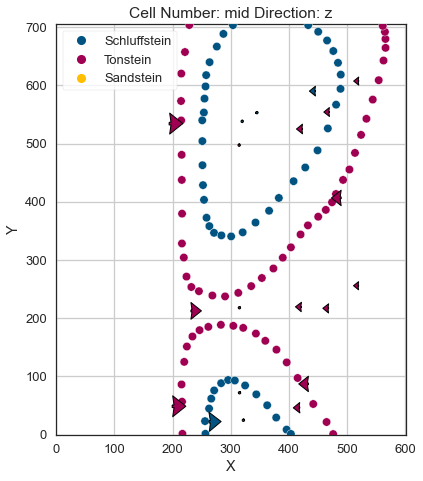
[32]:
gp.plot_3d(geo_model, image=False, plotter_type='basic', notebook=True)
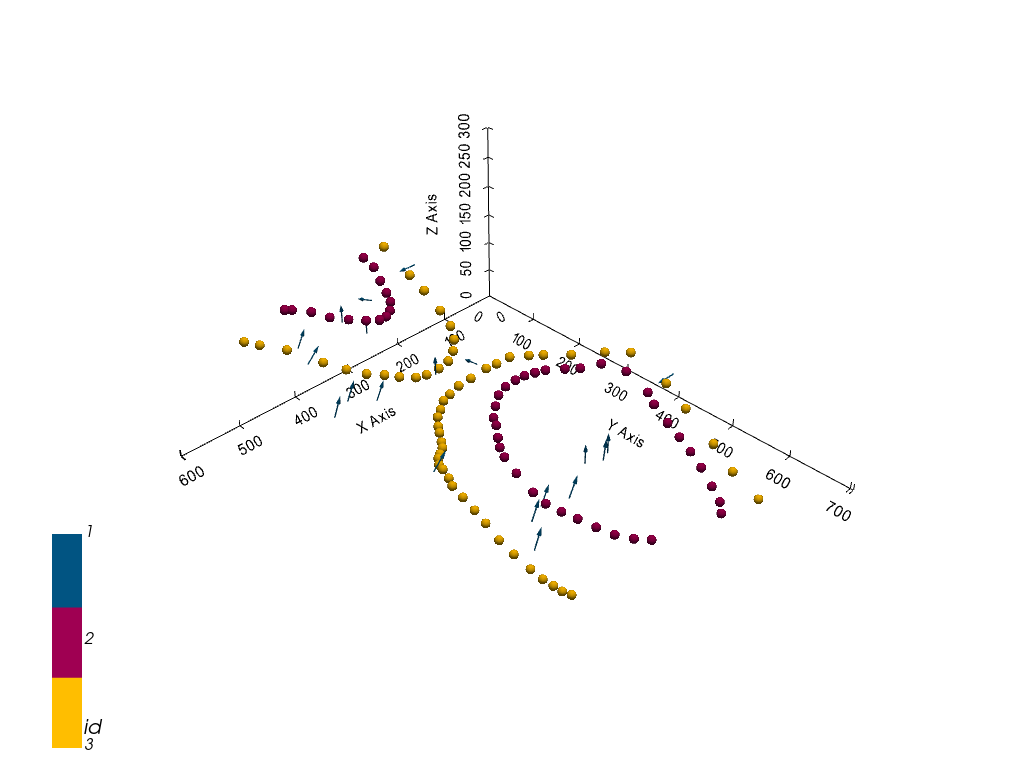
[32]:
<gempy.plot.vista.GemPyToVista at 0x23712e34eb0>
Setting the Interpolator#
[33]:
gp.set_interpolator(geo_model,
compile_theano=True,
theano_optimizer='fast_compile',
verbose=[],
update_kriging=False
)
Compiling theano function...
Level of Optimization: fast_compile
Device: cpu
Precision: float64
Number of faults: 0
Compilation Done!
Kriging values:
values
range 973.77
$C_o$ 22576.81
drift equations [3]
[33]:
<gempy.core.interpolator.InterpolatorModel at 0x2370bce2610>
Computing Model#
[34]:
sol = gp.compute_model(geo_model, compute_mesh=True)
Plotting Cross Sections#
[35]:
gp.plot_2d(geo_model, direction=['x', 'x', 'y', 'y'], cell_number=[25, 75, 25, 75], show_topography=True, show_data=False)
[35]:
<gempy.plot.visualization_2d.Plot2D at 0x23713b99f40>
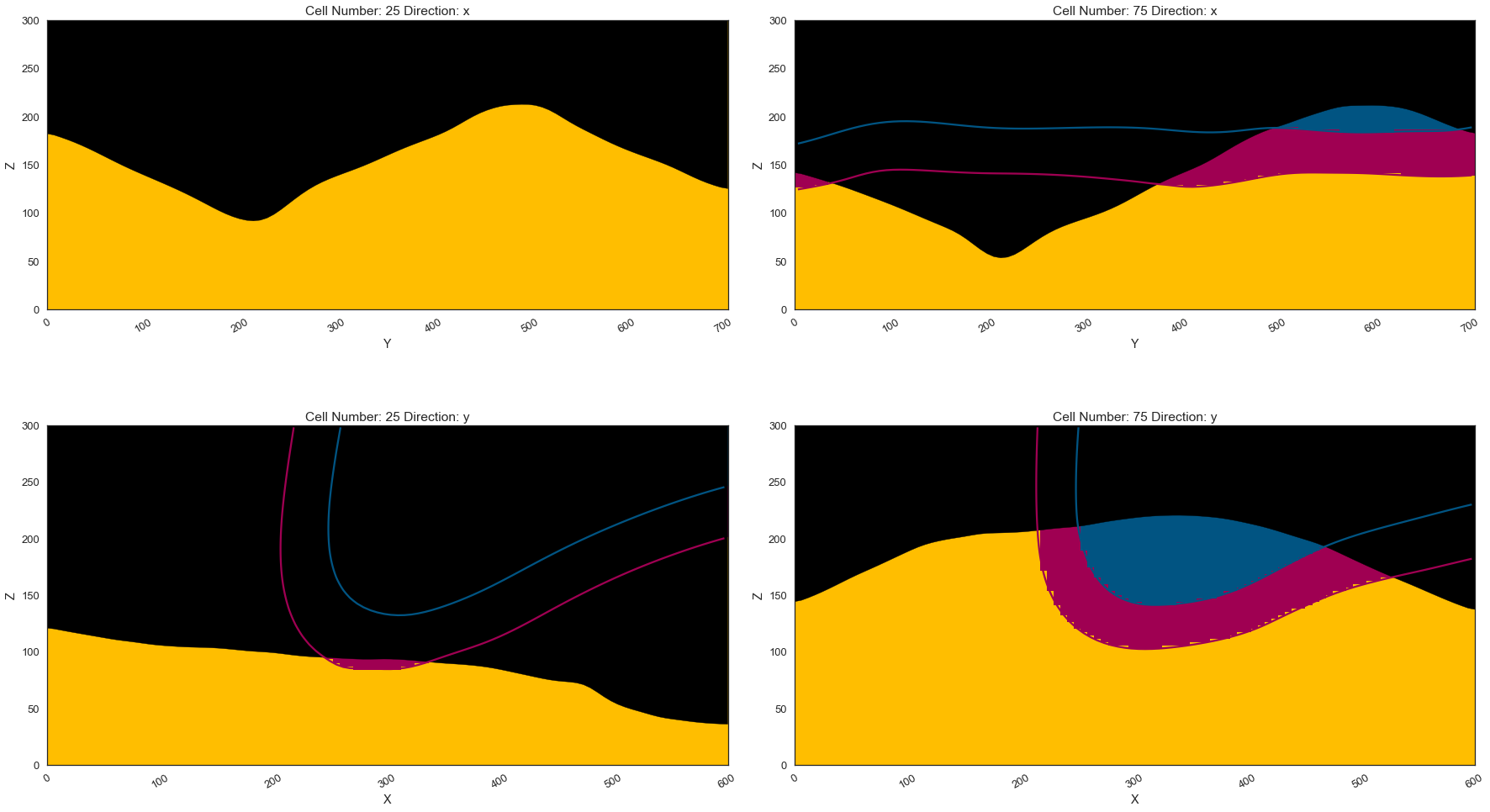
[36]:
gpv = gp.plot_3d(geo_model, image=False, show_topography=True,
plotter_type='basic', notebook=True, show_lith=True)
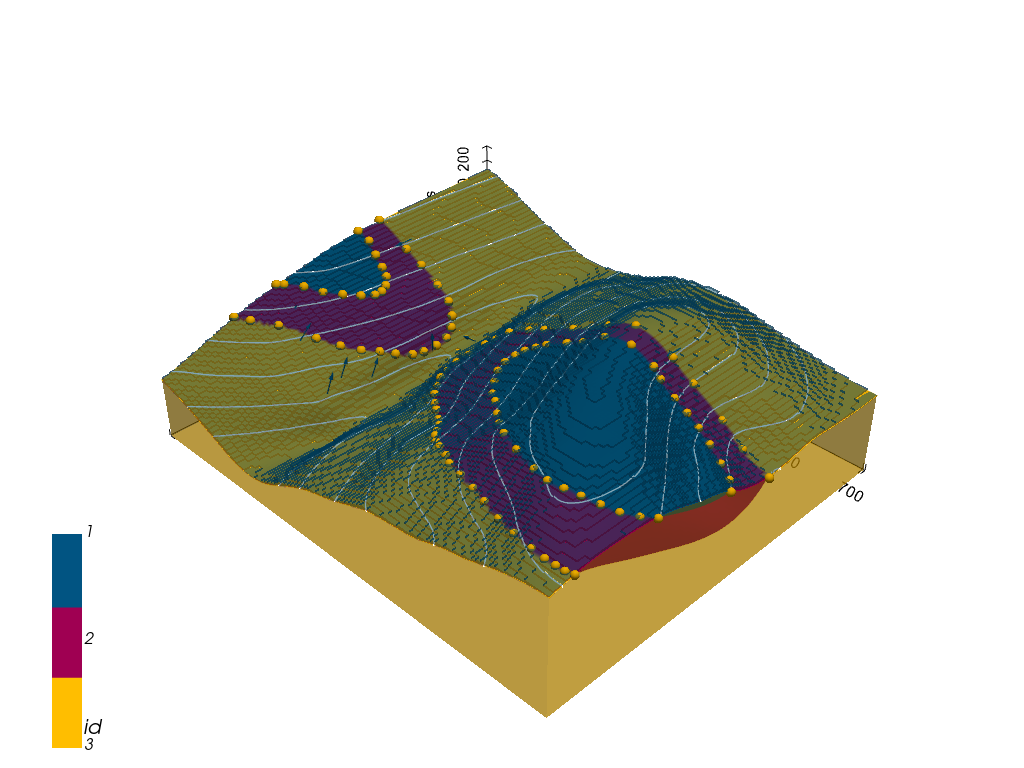
[ ]:
